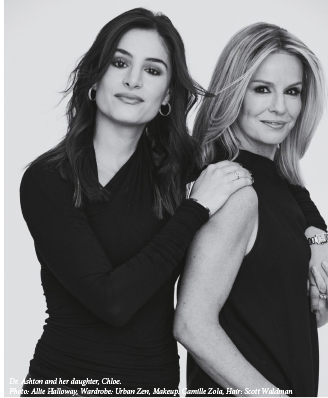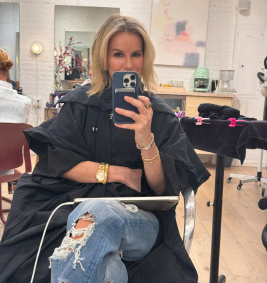THE FAUX-PO
A Lifesaver On So Many Levels

In today’s world of filters and optics, it can be easy to think that everyone’s appearance is perfect. When I started having hair problems, I was very public about the fact that I was using wigs and clip-on pony’s both on TV and off. Every time I shared this; it went viral. Hair loss affects millions of women. Yet hiding it is so common that when I spoke openly about it, the issue really resonated. Here’s my story.
When I experienced extreme hair breakage, I did what I’ve done hundreds of times in the operating room during a critical moment — I went into full-on medical response mode. Except this time, the patient was me, and the emergency was my hair (Ok, this might be slightly over-dramatized, but you get the point of the analogy).
This was not a case of a few split ends. My hair was breaking in ways I hadn’t seen before, and the more I tried to cover it up with styling, the worse it became. As a physician, I knew I had to take a step back, cast a wide net, and think like a clinician. What’s the cause? What are the risks? What’s the treatment? My hair needed help, fast.
I had to make sweeping changes like stopping highlights and daily styling, focusing on nutrition and supporting my hair from the inside out with targeted supplements; scaling back on shampoos and heat, product, and pulling that happens from styling for television every day. Just like stopping a bleed in the ER, I had to “stop the bleeding” on my head.
What I didn’t expect: the solution wasn’t just medical. It was also emotional and behavioral. I needed a confidence boost, something that allowed me to show up to work or social events, feel polished, and still give my hair the rest it desperately needed. That’s when I found my faux-po — a faux ponytail.
Let me say this clearly: the faux-po saved me. She was easy, elegant, and gave me that professional edge on-air while allowing my real hair to rest underneath. She’s what I like to call a “resuscitative accessory”—both fashionable and functional. Like a stylish little CPR for my scalp.
But it wasn’t just the faux-po. It was an all-out hair version of 911. Here’s what worked for me, and what might work for you:

REST: A major part of my hair situation was due to an occupational hazard. Having my hair professionally styled 5 days a week for 12 years when I was the Chief Medical Correspondent at ABC News destroyed my hair. The heat, the pulling, the products, the studio lights- it was a recipe for disaster. “Resting” it, with my faux-po, allowed me to still look presentable on air, or out with friends, but not subject my whole head to frequent styling damage.
WRAP IT UP: I did this too! I figured if it could work for J Lo, maybe it could work for me too! On days that my hair was a mess, but I had to go out, I would wrap my head in a chic silk scarf! It was more than a fashion accessory, it was protective. A snug wrap keeps hair from tangling and breaking. Plus, on days when shedding is especially frustrating, a wrap can shield both your strands and your self-esteem.
RECONSIDER COLOR: Personally, I used to get my hair highlighted roughly every 10 weeks. But once my hair was in crisis, I spaced that out to 12. It may not seem like a lot, but every little bit helps. If you’re going through a hair setback, now may be the perfect time to reconnect with your natural color. Or, if you do color, look for ammonia-free formulas. They’re less aggressive.
BRUSH EASY: Any hair expert will tell you: the weakest time for your hair is when it is wet. I know this presents a conundrum: how are you supposed to detangle your hair after washing it if you can’t brush it? Just give it some time to become damp (not wet) and use a wide tooth comb. And don’t brush your hair 100 times a day. I don’t.
PRODUCT TEMPERANCE: Scan ingredient lists—if alcohol is high on the label, think twice. Look for hydrating formulas and avoid those promising extreme hold or volume at the cost of strand health.

FIND YOUR SHAMPOO SWEET SPOT: There’s no one-size-fits-all. I now shampoo every 3–4 days, depending on how my scalp feels. Experiment until you find what keeps your hair clean but not stripped. It’s a balance between resting your hair and keeping your scalp clean.
THE BRAVE NEW WORLD OF WIGS AND HAIR PIECES: This was the single most helpful thing I did! Sometimes, the best thing you can do is take your hair out of the equation entirely—and that’s where wigs, clip-ins, and faux-ponytails come in. I never thought I’d wear one, but now I can say I love mine! Even though my hair has recovered, I will never stop using my faux-po! Choosing a faux-po or wig doesn’t mean giving up. It means taking control. It’s low-maintenance, polished, and gives your natural hair the space to breathe and repair. Plus, you can have fun with it—try a different length, wave, or color without any damage. It’s as much about saving time and preserving my hair as it is about fashion! I have been so transparent about my faux-po and I think that is why it’s worked for me. I don’t try to pass it off as my real hair, any more than I would try to pass off my lashes with mascara as being naturally long! To me, it’s no different than changing my earrings. And I love how easy it is!
FROM BREAKAGE TO BREAKTHROUGH: Resuscitating my hair was medical, emotional, and aesthetic. And just like in medicine, the key was being proactive, informed, and patient. If you’re going through something similar, know this: you’re not alone. There are beautiful, practical tools—like the faux-po—that can help you feel like you again. It requires time and patience, but your hair can improve!
To learn more about Dr. Jennifer Ashton and her free weekly advice for women,
please visit JoinAjenda.com





